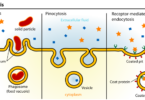eAll cells are surrounded by a cell membrane. There is no Difference between Cell membrane and Plasma Membrane as these are just the two names for one structure. Back in the day, this structure was called plasmalemma and now the names have been changes. This membrane is a separation between the extracellular matrix and the intracellular matrix. This membrane helps to protect the cell from its external environment.
Cell Membrane: Definition and Functions.
The cell membrane is composed of many molecules but it is abundant in lipids and proteins. The composition changes to maintain fluidity and it fluctuates during various stages of cell development. Biological molecules are added to or deleted from the membrane through vesicle fusion or exocytosis. This excretes the contents of the cell.
The cell membrane is composed of lipids of three types, glycolipids, sterol, and amphipathic lipids. However, phospholipid makes up the majority of cell membrane composition. These phospholipids are made up of fatty chains that are 16 to 18 carbons long. These fatty chains may be saturated or unsaturated. Length and saturation of fatty chains determine the fluidity of the membrane.
Covalent interactions hold the membrane together. 50% of the volume is of the cell membrane is made up of proteins. These proteins are involved in various activities such as cell identification and anchorage. Protein receptors also play a role in cell to cell communication.
Plasma Membrane: Definition and Functions.
There is no Difference between Cell membrane and Plasma Membrane as they both are the same thing. Plasma membrane surrounds the cell and contains all components of the cell. This membrane is semipermeable and it only allows some molecules to pass through it.
All the materials needed by the cell for survival are transported across the plasma membrane. There are channels and transporters in the membrane that take substances in and out of the membrane. Other materials are passed through the membranes through osmosis and diffusion.
Plasma membrane gives structure to the cell and regulates materials that are passing through the cell. Oxygen, water, ions, and other molecules enter and exit the cell through the cell membrane. The membrane also has a role to play in communication and cell signaling.
There are receptors present on the cell that bind to molecules such as protein hormones, antibodies, and drugs. Due to this interaction, signal transduction pathways start insider the cell and the process is carried out. The plasma membrane also protects the cell from harmful materials that are present outside the cell and aids in the cell to cell communication.
Summary Difference between Cell membrane and Plasma Membrane:
- The Difference between Cell membrane and Plasma Membrane is only the name since they both are the same thing.
- The membrane encloses protoplasm that makes up the whole cell.
- Cell membrane is composed mainly of lipids and proteins. It is not rigid but is fluid in nature.
- It is defined by fluid mosaic model in which lipids form the sea and proteins are suspended in it like glaciers.
- Cell membrane has a role to play protection, signaling and communication.






Leave a Comment
You must be logged in to post a comment.